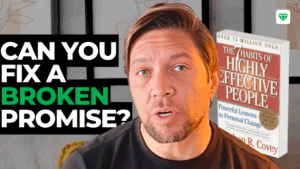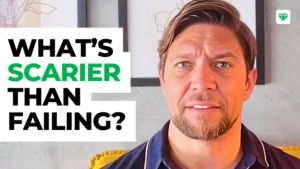
.
✅ FREE WORKBOOK: The 6 Routines of Balance: Syncing Productivity, Health, & Relationships For a Happier Life.
Listen to the Podcast Version
250,000 years ago, a single mistake could get you killed.
Failing to gather food. Breaking a tool. Losing a hunt.
Back then, being excluded wasn’t just awkward—it was a death sentence.
We don’t live in that world anymore… but your brain doesn’t know that.
It still treats mistakes like life-threatening risks. And every time you try something new, it kicks into survival mode—telling you:
“Be careful. Don’t mess this up. Your life depends on it.”
That paralysis—the hesitation, the second-guessing, the need to get it just right before you start?
That’s what we now call perfectionism.
In the book The Art of Learning, Josh Waitzkin says:
“Growth comes at the point of resistance. We learn by pushing ourselves and finding what really lies inside.”
But your brain is not wired for growth. It’s wired for survival.
And when it sees a chance of failure? It slams the brakes.
But what if the real problem is not that you’re a perfectionist… but that you are just using perfectionism as an excuse for not starting?
And if that’s true… then maybe the way forward is not to fight perfectionism—but to let it become part of the process instead of part of the problem.
Perfect (adj.) vs. Perfect (verb)
Think of a blank canvas.
The first brushstroke looks messy, unclear, unfinished… imperfect.
The point is… It doesn’t look like much. But as you keep adding layers—refining colors, sharpening details—the painting starts to emerge from the chaos.
Without the imperfect strokes of your draft there’s no masterpiece.
So when you think of “perfect” as an adjective, it’s rigid, unattainable. It feels final, like something you either achieve or you don’t.
But when you think of “perfect” as a verb, it’s active—it’s about refining, improving, and evolving.
Think about your favorite artist, musician, or speaker. Do you think they were ‘perfect’ the first time they picked up a brush, an instrument, or a microphone?
No. They kept refining. They perfected, instead of trying to be perfect.
Each action you take, each attempt to do something new is a brushstroke.
It might feel small on its own, but they create the basis of every masterpiece.
So, how do you move from “perfect”, as a state, to “perfect”, as a process? How do you create progress that feels tangible, even when things feel imperfect?
We’re going to use The Brushstroke Method. A system to break free of perfectionism paralysis and replace it with progress, just like painting a beautiful piece of art goes from an imperfect sketch to a masterpiece.
Painting Your Progress: The Brushstroke Method
The Brushstroke Method gives you three simple steps:
1. Sketch the Outline
2. Add the Base Colors
3. Add depth
Each brushstroke builds on the last, layer by layer, until progress becomes visible and tangible.
Brushstroke 1: Sketch the Outline
The first brushstroke is to sketch the outline.
In The Brushstroke Method, this means defining your Improvement Zone—a small, focused part of a skill or project.
If you focus on the final masterpiece, like “become a better reader” or “master public speaking,” it feels overwhelming. It’s too big. Too vague.
The path feels unclear, and the goal seems too far away. That’s what leads to perfectionism paralysis—you don’t know where to start, so you don’t start at all.
But when you focus on one specific aspect, the path forward becomes clear. You only have to take one step.
Let’s say public speaking is the skill you want to master.
What exactly do you want to improve? Think of key aspects like:
Vocal delivery – Controlling your tone, volume, and pacing.
Engagement – Keeping the audience hooked with body language and eye contact.
Transitions – Moving smoothly from one point to the next.
Now, pick one aspect.
For example, if you choose transitions, your Improvement Zone might be:
- Using a transitional phrase (e.g., “That brings us to…”) to connect ideas.
That’s your first brushstroke—one small, specific improvement that moves you forward.
Brushstroke 2: Add the Base Colors
The second brushstroke is to add the base colors. This is the broad, foundational stroke that creates structure for the painting.
In The Brushstroke Method, this is about creating Micro Refinements—small, deliberate actions that build momentum.
These refinements don’t need to be polished. They’re about progress, not perfection—laying down a base that will later be sharpened and refined.
Think of it this way: If your Improvement Zone is using a transitional phrase (e.g., “That brings us to…”) to connect ideas, your base colors might look like this:
Write down your main talking points and script a transition phrase between each one.
Practice saying your transitions aloud 3-5 times until they feel natural.
Record yourself speaking and listen for any awkward jumps, adjusting with a smoother phrase.
These are your base colors—the refinements that give life to your sketch.
Brushstroke 3: Add Depth
Now comes the fun part: It’s time to add depth.
In The Brushstroke Method, this is about Iteration—adjusting and improving what’s already there.
Here’s the beauty of iteration: It doesn’t erase mistakes—it transforms them. It builds on what’s already there, turning rough strokes and base colors into refined details.
Maybe your transitions still sound robotic or unnatural. That’s fine—iteration will refine them:
Experiment with different phrasing.
Try varying your voice tone.
Incorporate natural body language.
These small adjustments add depth, clarity, and confidence—but that mastery wouldn’t exist without the base layers underneath.
Progress isn’t about getting it perfect on the first try.
The Brushstroke Method doesn’t fight against perfectionism—it works with it.
- Instead of waiting for perfect conditions, you create momentum.
- Instead of chasing flawless results, you focus on layering progress.
- And just like a masterpiece, your skills take shape—one brushstroke at a time.
The One Question That Kills Perfectionism for Good
But even when you know this—when you’re applying the Brushstroke Method—there’s still something that happens…
That hesitation. The second-guessing. The tiny voice saying, “Maybe just one more tweak before I put this out there.”
Why does this happen? Why, even when you’re making progress, does perfectionism still try to creep back in?
Well… remember where we started.
Your brain still thinks mistakes mean danger.
So, what do you do when that happens?
First, remember to shift how you see “perfect.”
“Perfect” (adj.) is something you are or you aren’t.
“Perfect” (verb.) is something you do or you don’t.
Perfect is not about who you are—it’s about what you do, and what you do is always progressing.
So, whenever that hesitation creeps in, ask yourself:
What would this feel like if it were just the next brushstroke?
That’s it. One question. One shift. One step forward And perfectionism loses its grip.
- Instead of waiting to be ready, you start.
- Instead of obsessing over details, you refine.
- Instead of fearing imperfection, you embrace progress.
Because that’s how masterpieces are made.
Not in one stroke. Not in one moment of genius.
But in layers, built over time.
And now, you have everything you need to do the same.
So… what’s your next brushstroke?
Whatever it is—do it now.
One small brushstroke at a time, and soon, you won’t just create something incredible.
You will look back and realize—you were building it all along.





